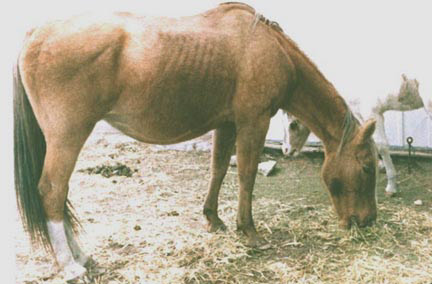Lady Gold, continued ...
|
Monday, just two days after we got the mare and colt, our
farrier, Philip Johnson, came over. He pronounced her sound --
no major problems with feet or legs. He was certain he could
fix her walking on her heels as soon as her hooves grew out a
bit.
That afternoon, the vet made it over. He pronounced her underweight
but healthy. He figured out how she had become so thin and weak.
The first clue, he said, was that her colt had a pink depression
ringing each hoof, about an inch and a half up from the soles.
"Foal founder. It means he nearly died at birth." |

Lady Gold's
right front hoof, 2 1/2 weeks after we got her. Note that the
front of the hoof tilts off the ground.
|
He pointed out that each of the mare's hooves also showed
a dark contracted ring near the coronet. (The coronet is where
the hoof wall meets the fur above.) She, too, must have nearly
died while foaling. Her hooves were also lined with superficial
cracks. The vet said that meant that she had long suffered a
nutritional deficiency. The good news was that she was sound,
no arthritis, just understandably tender from walking on hooves
worn to the quick. She also wasn't terribly old, about fourteen.
Next the vet "floated" her teeth, rasping off all
the uneven points. This enabled her to chew more easily. She
was going to have to eat almost constantly over the next few
months to nurse her colt and gain back her muscles. He also gave
her vaccinations and treated her for both internal and external
parasites. The worst challenge was the thousands of pinhead-sized
little red things infesting her hide: ticks. The vet provided
a liquid with which I bathed her.
Now that we knew they were basically sound, the girls and
I got together to name them. We agreed on Lady Gold, because
we knew she would be full of spirit and power some day, and Xerxes,
after the ancient Persian conqueror.
The very next night, a snowstorm hit. We moved Lady Gold and
Xerxes into an outbuilding that we hastily modified to become
our hospital barn. They slept in a warm stucco stall on a sawdust
bed. Through the storm, Coquetta, instead of sleeping in the
main horse barn, stood watch next to the hospital barn.
The next morning, it was finally safe to let Lady Gold eat
all the alfalfa she wanted. Over the next four days we phased
in sweet feed and Starshine (a nutritional supplement). Also,
I groomed and massaged her twice every day. However, there was
more work ahead of us before she would reach optimum health,
and much more winter.

Figure 2: Lady Gold and Xerxes, two and a half weeks after
we bought them. She was still in the stage of vacuuming up food
every waking hour. In this view she had been released from her
hospital pen for her daily exercise. She was now checking out
some hay that fell out of the other horses's feeder, presumably
wondering if theirs tastes better than hers.
# # #
Next chapter: The Blizzard
-->>
Back to the Table of Contents for
Killer Buyer

